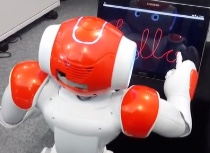Kids and robots learn to write together
March 5, 2015

A humanoid robot struggles to reproduce letters on a tablet. A young girl steps in to help, writing out the word to show the robot how to do it … without realizing that in reality she is the one who is improving her writing skills (credit: EPFL)
EPFL researchers have developed a new teaching tool called CoWriter based on the pedagogical principle of “learning by teaching.”
When children experience difficulties in writing, they can easily lose confidence, begin to shut down, or even gradually lose interest in the learning process. Eventually, their entire education can be affected. When students put themselves in the place of a teacher and pass on what they know to their peers, they can regain their self-esteem and motivation.
The researchers’ idea was to make a robot play the role of the peer who needs to be taught. “Essentially, the goal is to provide a tool for teachers — a student who knows even less than the slowest student in the class,” explains Séverin Lemaignan, one of the authors of an open-access paper in Proceedings of the Tenth Annual ACM/IEEE International Conference on Human-Robot Interaction.
The robots can play the role of a naive learner, which neither adults nor peers (because of the social effects it would induce) can convincingly play, the authors note.

Nao robot attempting to write a word (credit: EPFL)
Letter-drawing algorithms with a teaching goal
The scientists developed progressive writing algorithms and implemented them on an existing robot model — a 58 cm. tall Nao humanoid, designed to be likeable and interact with humans. With these algorithms, the machine can clumsily draw (intentionally) words on demand, and then gradually improve.
To do this, it uses a vast database of handwriting examples, which allows it to reproduce common errors made by young children while learning. It is also possible to program the robot so that it addresses the particular difficulties of a student, for example, by drawing a P that is barely readable and improving its form over time.
The CoWriter system, still in the prototype stage, has already been used in primary school lessons with about 70 students ranging from six to eight years old, and then individually with a six-year-old child for one hour per week over the course of one month.
CoWriter is an invention of the EPFL’s Computer-Human Interaction Lab in Learning and Instruction and Learning Algorithms and Systems Laboratory (LASA). It was introduced at the Conference on Human-Robot Interaction (HRI) held in Portland March 2–5.
EPFL | Kids and robots learn to write together (sous-titres en français)
Abstract of When children teach a robot to write: An autonomous teachable humanoid which uses simulated handwriting
This article presents a novel robotic partner which children can teach handwriting. The system relies on the learning by teaching paradigm to build an interaction, so as to stimulate meta-cognition, empathy and increased self-esteem in the child user. We hypothesise that use of a humanoid robot in such a system could not just engage an unmotivated student, but could also present the opportunity for children to experience physically-induced benefits encountered during human-led handwriting interventions, such as motor mimicry. By leveraging simulated handwriting on a synchronised tablet display, a NAO humanoid robot with limited fine motor capabilities has been configured as a suitably embodied handwriting partner. Statistical shape models derived from principal component analysis of a dataset of adult-written letter trajectories allow the robot to draw purposefully deformed letters. By incorporating feedback from user demonstrations, the system is then able to learn the optimal parameters for the appropriate shape models. Preliminary in situ studies have been conducted with primary school classes to obtain insight into children’s use of the novel system. Children aged 6-8 successfully engaged with the robot and improved its writing to a level which they were satisfied with. The validation of the interaction represents a significant step towards an innovative use for robotics which addresses a widespread and socially meaningful challenge in education.
